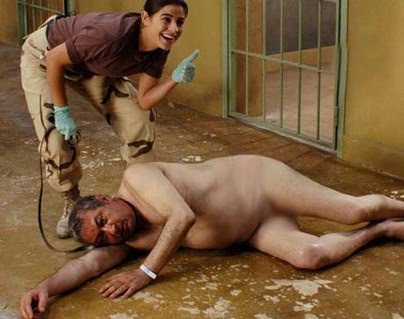The greatest threat to that safety lies not in the photographs of horrific behavior; it lies in the fact of the behavior itself.

 A hooded man standing on a box, electrodes wired to his fingers. A naked prisoner lying on a cement floor, a leash around his neck held casually by an American soldier. The bloody bodies of dead inmates with their heads bashed in.
A hooded man standing on a box, electrodes wired to his fingers. A naked prisoner lying on a cement floor, a leash around his neck held casually by an American soldier. The bloody bodies of dead inmates with their heads bashed in.
Ten years later, the photos leaked from Abu Ghraib prison in Iraq remain seared into the American consciousness. But while the United States government was unable to prevent their release, more than 2,000 other photos taken at various American military facilities in Iraq and Afghanistan have remained hidden under a 2009 law. By one account, the images — which officials say are a mix of snapshots by soldiers and photos by military investigators documenting allegations of abuse — are “worse than Abu Ghraib.”
On Wednesday, the American Civil Liberties Union won an important victory for transparency when a federal district judge in New York City, Alvin Hellerstein, rejected the government’s blanket claim of privilege for all the photos. Judge Hellerstein ordered the government to show why the release of the photos would endanger American lives, and to show that it had considered each photo individually.
President Obama agreed to the photos’ release after taking office in 2009 but changed his mind after pleas from military officials and Iraqi Prime Minister Nuri Kamal al-Maliki. The 2009 law — the Protected National Security Documents Act — created a three-year exemption from the requirements of the Freedom of Information Act.
Judge Hellerstein accepted the government’s first declaration, made in 2009, that it would withhold the photos. But he was more skeptical of its decision to do that again in 2012 because, he said, the public-safety rationale may have grown weaker with the passage of time.
“Three years is a long time in war, the news cycle, and the international debate over how to respond to terrorism,” the judge wrote. The law was enacted during a war, but the 2012 request, essentially identical to the original, came under different circumstances. “I am aware of no impassioned plea from the prime minister of Iraq relating to the photographs made at that time,” he said.
It may be fairly easy for the Obama administration to satisfy this order and continue to keep the photographs from public view, but that would not make it right. The government should end the secrecy and release the photos.
Images of war are frequently appalling, and the safety of American citizens and soldiers is vitally important. But the greatest threat to that safety lies not in the photographs of horrific behavior; it lies in the fact of the behavior itself. The treatment of Iraqi prisoners at Abu Ghraib and elsewhere was a shameful episode in U.S. history.
America reinforces its values and thus its security by being transparent about even the worst abuses of those values, not by hiding the evidence deep in a file drawer.
No comments:
Post a Comment